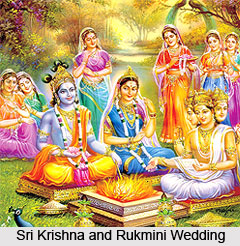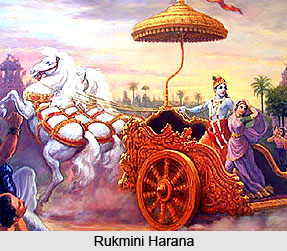 Rukmini is renowned in Hindu legends. She is the principal wife of Lord Krishna of Dwarka. She eloped with Krishna and married him. Rukmini is considered to be an incarnation of Devi Lakshmi, the goddess of fortune.
Rukmini is renowned in Hindu legends. She is the principal wife of Lord Krishna of Dwarka. She eloped with Krishna and married him. Rukmini is considered to be an incarnation of Devi Lakshmi, the goddess of fortune.
Rukmini was born in the month Vaishakha. Lakshmi by Her portion took birth in the earth as Rukmini in the family of Bhismaka. As Lakshmi is Vishnu`s Shakti so Rukmini is Krishna`s strength and thus cannot be separated.
Rukmini was the daughter of Bhishmaka, the king of Vidarbha. Rukmini fell in love with Krishna and she had heard the virtue, character, charm and greatness of Krishna. Krishna also fell in love with Rukmini as she was the most sought after, virtuous and beautiful princess on Earth. Rukmini`s eldest brother Rukmin though was a friend of evil King Kamsa, who was killed by Krishna, and was set against the marriage.
Rukmini was getting married to Krishna but her brother Rukmin strongly opposed and changed Bhishmaka, their father`s mind. Rukmin was an ambitious prince and wanted his Rukmini to be married to his friend Shishupala, the crown prince of Chedi. Shishupala was also a vassal of Jarasandha and hence a friend of Rukmin.
Rukmini came to know about the conspiracy and immediately called the Brahman, Sunanda upon whom she had faith. She and asked him to deliver a letter to Krishna. She asked Krishna to come to Vidarbha so that she could elope with Krishna. Rukmini begged to Krishna not to fight because in the battle many of her relatives would die. She recommended that she would run off with Krishna on her way to the temple or back. Rukmini asked that he claim her to marry her. If Krishna refused to do so then she would commit suicide. After receiving the letter Krishna set off to Vidarbha with his elder brother Balarama.
In the meantime, Shishupala was delighted to get the news from Rukmin that he could marry Rukmini. Jarasandha, not so trusting, sent all his armies and associates along because he felt that Krishna would certainly come and run off with Rukmini.
 Bhishmaka and Rukmini received the news that Krishna was coming by their individual secret agent. Bhishmaka secretly accepted Krishna and wished that Rukmini get married to him. Bhishmaka made palace especially for Krishna.
Bhishmaka and Rukmini received the news that Krishna was coming by their individual secret agent. Bhishmaka secretly accepted Krishna and wished that Rukmini get married to him. Bhishmaka made palace especially for Krishna.
After Krishna and Balarama reached Bhishmaka welcomed them joyfully and made them comfortable. In the palace, Rukmini got ready for her forthcoming marriage. She went to the temple to pray but was severely disappointed when she did not see Krishna there. Inside the temple, she prayed to goddess Parvati so that Krishna would come and wed her.
Rukmini went out of the temple when she saw Krishna and he soon put her into his chariot with him. They both started to ride off when Shishupala noticed them. All of Jarasandha`s armed forces quickly started chasing them. While Balarama occupied most of them and held them back Rukmin had almost caught up with Krishna and Rukmini. Krishna was about to kill him, Rukmini fell at the feet of Krishna and begged that her brother`s life be spared. Krishna being big hearted agreed to spare Rukmin`s life but as a punishment shaved Rukmin`s head and set him go free. This was a sign of shame of the warrior who is defeated in the field.
The first son of Queen Rukmini was Pradyumna. She had nine other sons` ad one daughter. The other sons were Charudeshna, Sudeshna, Charudeha, Sushena, Charugupta, Bhadracharu, Charuvinda, Sucharu, and the very mighty Charu. The only daughter`s name of Krishna and Rukmini was Charumati. At Krishna`s death she and seven other of his wives immolated themselves on his funeral pile.




















